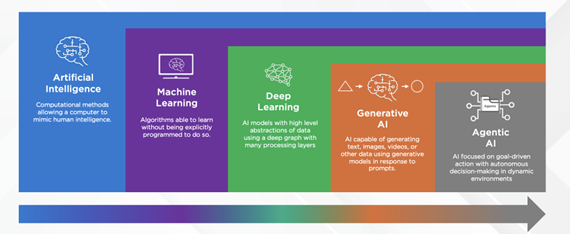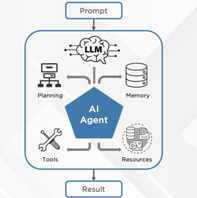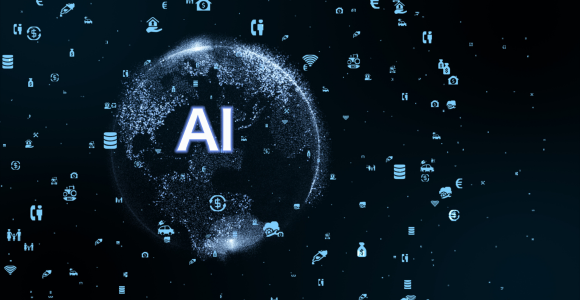Artificial Intelligence (AI) continues to evolve rapidly, bringing with it a flood of new terminology, capabilities, and integration options. For IT leaders, the challenge isn’t just keeping up but knowing which advancements to prioritize and which to let mature. Within this next generation of AI, Agentic AI is standing out as more than just another buzzword. It’s already being deployed across industries and redefining what automation is as a whole. According to recent data, 72% of organizations are already using agentic AI systems, and over 96% plan to expand their usage over the next 12 months. Stick with us as we explore what agentic AI is, how it differs from traditional AI models, and what IT teams should consider as they build toward the next generation of automation.
What Is Agentic AI?
While most IT leaders are familiar with generative AI tools like ChatGPT and image generators, agentic AI represents a significant step forward. Agentic AI identifies tasks, plans workflows, and executes with minimal human intervention. This results in less reliance on humans to guide every interaction, leading to a potential future where AI is capable of acting as a primary digital workforce. Unlike traditional automation tools, which typically follow more rigid scripts, agentic AI is capable of reasoning, adaptability, and multi-step execution.

Why IT Leaders Should Pay Attention Now
Agentic AI may be nearing the peak of its hype cycle, but real-world use cases are emerging rapidly. Organizations are now implementing early agentic systems, many of which include traditional automation tools enhanced by large language models (LLMs), to streamline customer service, software development, and internal support workflows.
Significant investments are accelerating the pace of innovation. From deep reasoning agents to multi-agent orchestration platforms, the ecosystem is expanding rapidly. Forecasts indicate that by 2028, over a billion AI agents will be developed and deployed. The implications for IT operations continue to increase.
The Building Blocks of Agentic AI
To deliver autonomous capabilities, AI agents rely on a modular architecture. Key components include:
- Interaction Layer: Prompts, context, perception
- Models: Large Language Models (LLMs), smaller domain-specific models, reinforcement learning models
- Memory: Short-term, long-term, global, and localized memory to support learning and recall
- Tools: APIs, automation systems, observability platforms, guardrails, browser agents, and more
- Resources: Vector databases, configurations, document repositories
- Orchestration: Planning logic, tool selection, invocation routing, and response management
These capabilities enable agents to move beyond simple command execution and instead plan, reason, and act intelligently across systems.

This diagram shows the internal composition of an advanced agent that leverages resources, tools and memory to boost context and functionality.
Understanding Agent Interactions
As AI agents become more capable and interconnected, their ability to access context, share tasks, and collaborate is now more than a nice-to-have. Having the proper foundation when building these systems is imperative. Two open frameworks are leading this shift: Model Context Protocol (MCP) and Agent-to-Agent Protocol (A2A). Both aim to standardize how agents operate in increasingly complex environments, but they serve distinct functions.
When evaluating these protocols, it’s important to understand their similarities, differences, and the specific use cases they support.
Model Context Protocol (MCP): Extending What an Agent Can Do
MCP helps AI agents interact with tools, memory, and external data. Most AI models are stateless by default, meaning they only have access to the information provided in the current prompt. MCP changes that by enabling:
- Secure access to tools and APIs
- Integration with local and long-term memory
- Real-time context enhancement using files, vector databases, or other resources
MCP is ideal when building agents that need to draw from prior interactions,
connect to enterprise systems, or make decisions based on data that lives outside the initial prompt. It reduces the need for brittle, one-off integrations and brings structure to how agents connect with their environment.
Agent-to-Agent Protocol (A2A): Powering Multi-Agent Collaboration
A2A focuses on enabling communication between multiple AI agents, even if they were implemented using different tools or platforms. Each agent publishes a standardized “Agent Card,” which includes:
- Descriptions of its capabilities
- Endpoint location and usage details
- Metadata to support discovery and communication
This protocol increases the ease of searching, assessing, and collab
orating, laying the groundwork for distributed, collaborative systems. In short, A2A is best for environments where agents need to delegate work, coordinate across tasks, or operate in real-time with other agents. It brings scalability and teamwork to agent-based systems.
Do You Need One, the Other, or Both?
For many enterprises, the answer is both. A modern Multi-Agent Architecture encourages an AI agent to use MCP to enforce standards and enrich its interactions with external data and systems, while also using A2A to delegate specific tasks to separate cooperating agents. Together, these protocols support both intelligent autonomy and scalable collaboration. While using both MCP and A2A doesn’t automatically make a system agentic AI, it does provide the technical foundation to support your blooming agentic behaviors.
As IT leaders explore agentic AI, it is essential to design with interoperability in mind. Whether you are building one agent or hundreds, support for MCP and A2A will determine the effectiveness of your system evolution and how well they work together.
Governance and Best Practices for IT Leaders for Operationalizing Agentic AI
As agentic AI moves from concept to implementation, it introduces powerful capabilities, but also new risks and responsibilities. Without proper oversight, autonomous systems can behave unpredictably, introduce security and compliance issues, or drive up cloud costs. That’s why the foundation of any AI initiative needs effective governance incorporated into it.
For IT leaders, success depends on striking the right balance between innovation and control. Below are key areas to focus on when deploying agentic AI across the enterprise:
- Adopt a governance-first mindset. Treat AI agents as business-critical software by establishing role-based access, auditing, observability, and policies for cost containme
nt, especially as token usage and API calls increase with scale. - Understand architectural depth. Ask how an agent is structured. What tools and external resources does it access? Is it following a static workflow, or using dynamic planning and reasoning?
- Know your platform’s limits. Evaluate constraints such as prompt size, memory scope, number of documents per query, or token usage. These technical boundaries often shape the effectiveness of your agent deployments.
- Ensure interoperability. Prioritize platforms that support open standards, like MCP and A2A. These frameworks enable multi-agent systems to scale, evolve, and work seamlessly across your existing infrastructure.
- Avoid shadow AI. Unmonitored or unapproved deployments can lead to inconsistent outcomes, policy violations, or security gaps. Visibility and governance must extend across the entire AI lifecycle.
Agentic AI has the potential to reshape how work gets done, but only when designed with discipline. With the correct guardrails in place, IT leaders can deploy intelligent agents that are scalable, secure, and aligned to business priorities.
Taking the NEXT Step
Agentic AI’s integration into today’s world is already happening, but taking the next step within your company can be daunting. Moving from experimentation to execution requires a clear understanding of architecture, governance, and where agentic AI fits within your broader IT strategy. That’s where the Verinext team can help. From evaluating platforms and protocols to designing secure, scalable frameworks, we work alongside IT leaders to turn complex ideas into real-world results.
Are you ready to take the next step? Watch our latest webinar on the topic or connect with an expert today to explore how we can help you plan, build, and operationalize agentic AI with confidence.
Related Posts:






